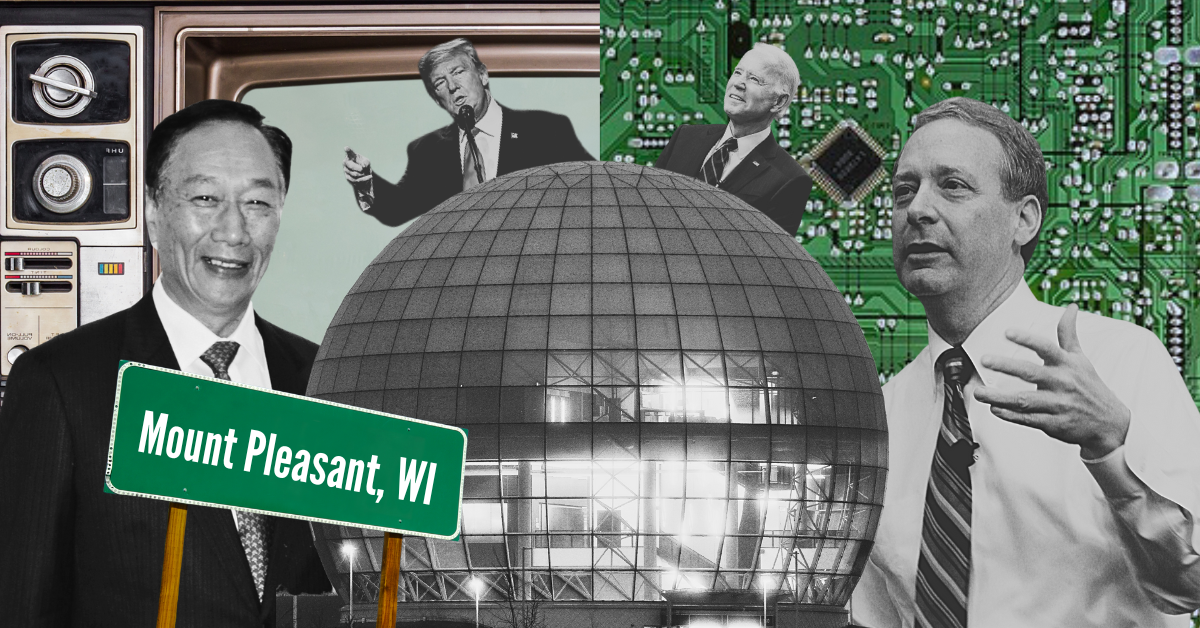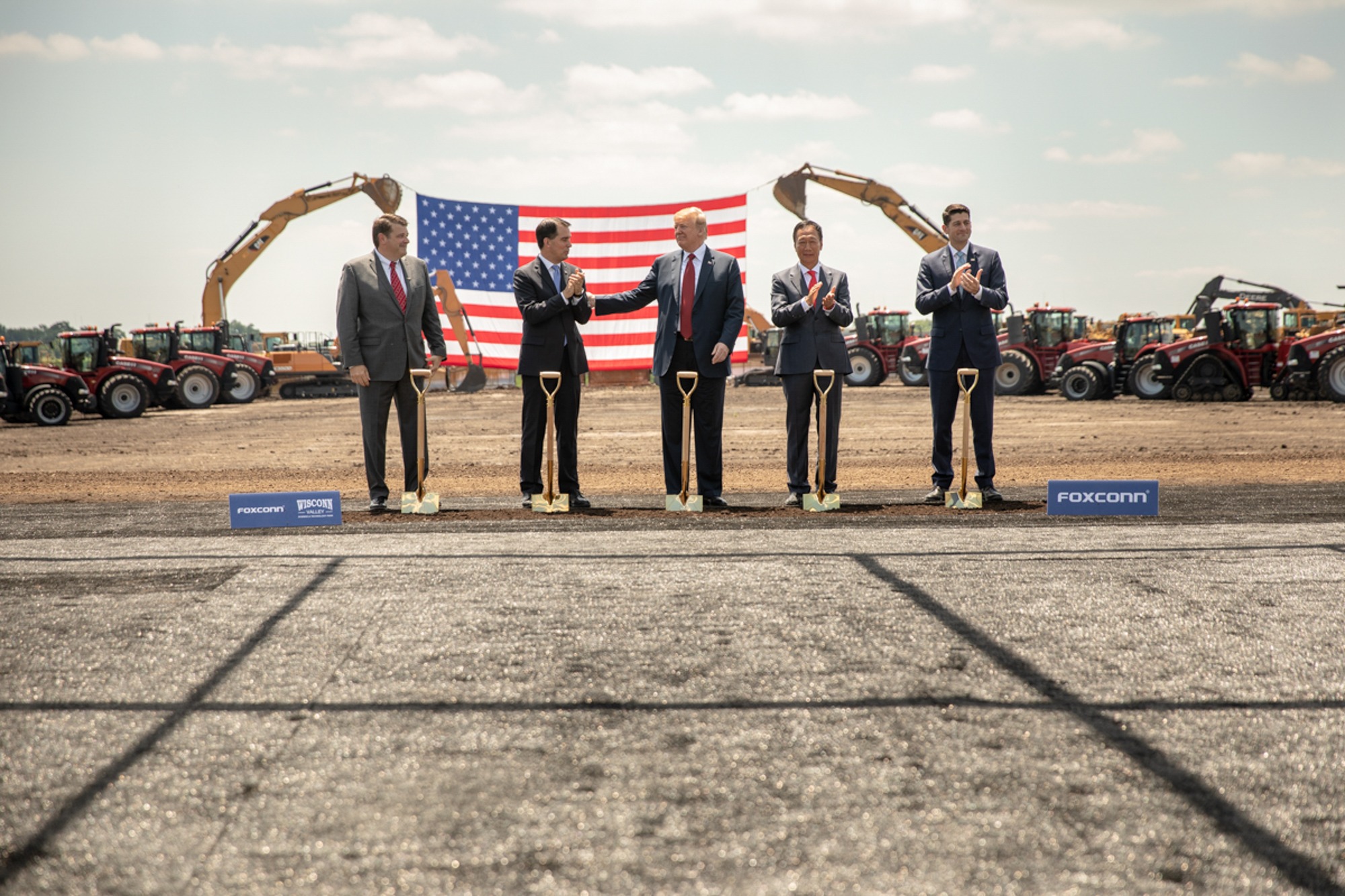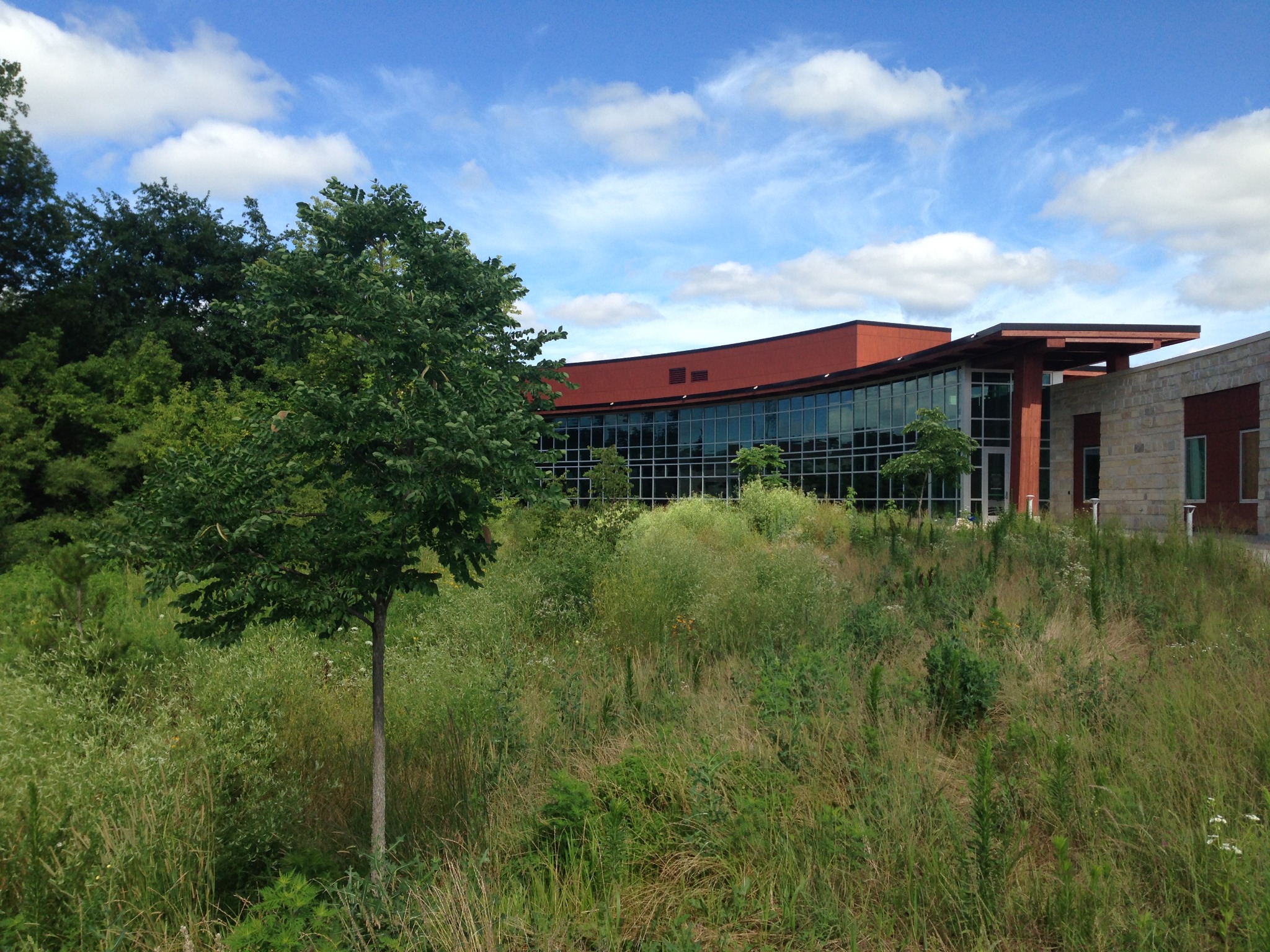
From ‘Eighth Wonder of the World’ to the ‘Great American Comeback Story’: How a Wisconsin Town Becomes the Focus of Re-Industrializing the Midwest
In 2017, Taiwanese electronic manufacturer Foxconn announced its plan to build a $10-billion, 13,000-people display factory in Mount Pleasant, Wisconsin. But the factory never came, and much of the land it claimed remains empty. Now, residents are hoping Microsoft will follow through with building an artificial intelligence data center at the same site. Cover graphic by Casey He for Midstory.
The village of Mount Pleasant, Wisconsin, population 27,000, doesn’t make headlines often.
The tranquil village is a “bedroom community” of Racine, the city to its east and triple its size, Kelly Gallaher, a local community organizer and resident for over 30 years, said.
“We have a lot of the chain restaurants and more shopping-strip type of shopping,” Gallaher said. “But where I live in Mount Pleasant, I can walk a couple of blocks and I'm in the city of Racine.”
Like many other Rust Belt locales, Racine County, which includes Mount Pleasant and Racine city felt the brunt of de-industrialization at the turn of the century. The county lost roughly 8,000 of the 25,000 jobs in its manufacturing sector in the two decades since 1990, according to the U.S. Bureau of Labor Statistics.
In 2017, however, the residents of Mount Pleasant would learn about the potential of seismic changes coming to their community — and from a ceremony staged at the White House, where former President Donald Trump hosted Terry Gou, then chief executive of the Taiwanese electronic manufacturing giant Foxconn, known for assembling iPhones at its global factories.
Trump said Foxconn was committed to investing $10 billion to build a manufacturing facility for liquid-crystal display (LCD) — a type of flat-panel display commonly used in televisions, monitors and mobile devices like smartphones — and create up to 13,000 jobs in Wisconsin. In exchange, Wisconsin promised Foxconn $3 billion in tax incentives, at the time the fourth-largest incentive deal in United States history according to The New York Times’ reporting.
In October 2017, Foxconn officially announced Mount Pleasant as the site for its Wisconsin facility, after the village and Racine County presented the company an additional $764 million in incentives and offered to acquire from residents over 3,000 acres of land — more than one-tenth of the village’s land mass.
At the June 2018 groundbreaking ceremony, Trump touted the soon-to-be facility as the “Eighth Wonder of the World” and vowed to reclaim America’s “proud manufacturing legacy.”

Gallaher said the investment and jobs the company promised initially excited her and many others in the village. But then, red flags began to emerge as journalists flocked to Mount Pleasant to cover the project, she said.
Investigative reporter and author Lawrence Tabak was one of the journalists who came to Mount Pleasant to follow the Foxconn project. The magnitude of the project attracted his attention, he said. His reporting, however, revealed the not-so-pleasant history behind Foxconn’s successes.
In 2013, Gou, the Foxconn head, announced that the company would invest $30 million to build a factory in Harrisburg, Pennsylvania and hire 500 workers. The factory was never built. Foxconn also made investment pledges in Brazil and Indonesia that eventually fell short of their ambition.
“People in the industry pretty much had [Foxconn] pegged as willingly promissory and regularly disappointing,” Tabak said. “That was kind of their tagline: ‘Big promises, little delivery.’”
Regardless, the previous episodes did not prompt government officials to apply heightened scrutiny to their deal with Foxconn, Tabak said.
Meanwhile, the Mount Pleasant government was keeping the residents in the dark about its negotiating with Foxconn, Gallaher said. She recalled information meetings, but no real opportunity for residents — several of whom were set to have their homes bulldozed to make way for Foxconn’s facility — to give their input.
“It wasn't the kind of thing where Village Hall said to the community, ‘Do you want to do this? Is this an appropriate use of what is basically 13% of the land mass in our village?’” Gallaher said. “We didn't even know what was in the local development agreement until the day they published it, and then they passed it that night.”
Mount Pleasant did not respond to Midstory’s request for comment.

The initial trajectory of Foxconn in Mount Pleasant seemed to follow what Gallaher and Tabak foresaw. Days before Trump wielded a golden shovel at the groundbreaker in Mount Pleasant, Foxconn announced that it was building a smaller plant instead of the facility it initially promised.
Since then, Foxconn floated plans to manufacture coffee machines, electric vehicles and batteries at the Mount Pleasant site, and after some construction was completed, the company made masks there during the COVID-19 pandemic. But the LCDs that were central to Foxconn’s initial promise have yet to be produced.
In 2021, Foxconn inked a new deal with Wisconsin, under Democratic Governor Tony Evers, that all but abandoned the plan for the 13,000-people factory by cutting back its planned investment to $672 million and job creation to less than 1,500.
“‘We're going to have to prove that that is just the spark that ignites a much bigger economic engine, and we'll have our very own Silicon Valley right here. We’ll even call it Wisconn Valley.’ That's how it got justified,” Tabak said of the original agreement and an early nickname for the project. “It wasn't based on a clear, methodical scientific basis. It was expedited for political reasons.”
Foxconn did not respond to Midstory’s request for comment.
To date, six years after the groundbreaking, just four buildings stand on the site where Foxconn promised the LCD factory, including three manufacturing facilities and a globe, which Foxconn claimed to be a data center. Gallaher, however, said the structure had been available to rent for outside events.
Although Foxconn continues to have a presence in Mount Pleasant — in 2023, the company said it had invested more than $1 billion, created around 1,000 jobs in Wisconsin and considers the Mount Pleasant plant “a strategic asset” — Gallaher said she doesn’t see a future for the manufacturing giant in her community.
“In a town this size, you run across people who work for a company. Some place that is going to employ 1,000 people is part of the fabric of the community. Foxconn has never been that,” she said. “They are not community stewards. They don't do anything for the community. They don't even sponsor a little league football team.”
While Foxconn was experimenting with different ventures at Mount Pleasant, the land it sits on has also been attracting other companies — aside from Foxconn’s investment, the village government and Racine County had also poured in several hundred million dollars for infrastructure improvement. In 2021, the site was a finalist for Intel’s planned semiconductor manufacturing plant but lost to New Albany, Ohio.
The change finally came in March 2023, when Microsoft announced plans to build a data center for artificial intelligence on more than 1,000 acres of land earmarked for Foxconn. Microsoft operates more than 300 data centers around the world.
In a visit to Mount Pleasant in May to announce Microsoft’s $3.3 billion investment in the data center, President Joe Biden hailed the project as the “great American comeback story.” The facility would create 2,300 union construction jobs and 2,000 permanent jobs, he said, a centerpiece of the effort to create high-paying, high-skilled jobs in Wisconsin under his administration.
Tom Still, the president of Wisconsin Technology Council, a nonprofit that advises the governor and state legislature on science and technology, said Mount Pleasant was a natural choice for Microsoft’s data center. Apart from the existing infrastructure, the site is strategically located in an area with a stable climate and in between Midwestern metropolitans, he said.
In the long run, Still said Wisconsin is also well positioned to take advantage of AI technology. The state’s major industries, from food and beverage processing and industrial machinery to chemical and medical products, could be more efficient and productive with the help of AI.
Microsoft has also committed to investing in Wisconsin communities beyond the new data center, Still said. As a part of its investments, Microsoft is partnering with Gateway Technical College to build a data center training academy and prepare local students for careers at the data center and in the high-tech sector. It is also collaborating with Wisconsin venture capital firm TitletownTech to build an AI lab at the University of Wisconsin-Milwaukee that will connect area manufacturers with AI experts and developers.
Microsoft did not respond to Midstory’s questions.
While the memory of Foxconn’s broken promises and skepticism may linger, Still is optimistic about Microsoft’s plan.
“I think the confidence factor over time, as this project rolls out, will become much stronger. And I don't see Microsoft turning its back on this project in any way,” he said.
Tabak echoed Still’s optimism. A key difference between Foxconn and Microsoft’s projects, apart from the vast differences in scale, he said, is the strategic importance between display panels and AI or semiconductor manufacturing, which the Biden administration has made its priorities.
The CHIPS and Science Act of 2022 would funnel more than $52 billion into the American semiconductor industry and research and development efforts to build a resilient chip supply chain in the U.S. In October 2023, Biden also signed an executive order on AI — to date the federal government’s most comprehensive effort to regulate the technology — that directs federal agencies to study and rein in AI in their respective domain.
Likewise, Gallaher remains hopeful that the Microsoft data center will come to fruition. But she said she remains clear-eyed about Foxconn and the project’s fallout, and she plans to continue making it a “part of the public conversation” and help other community members to hold the local government accountable.
“The interest in how this happened and how it went wrong is legitimately fascinating,” Gallaher said. “It was not my life's mission to talk about this for as long as I have, but I understand why we continue to do so, because there is a lesson in it for other communities like us, so we're happy to be that cautionary tale."
Post a comment